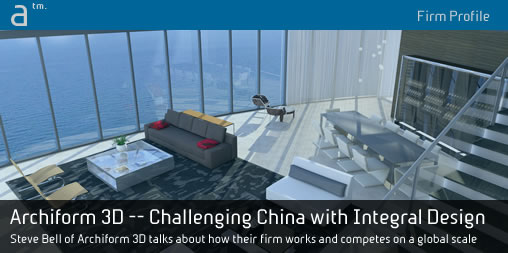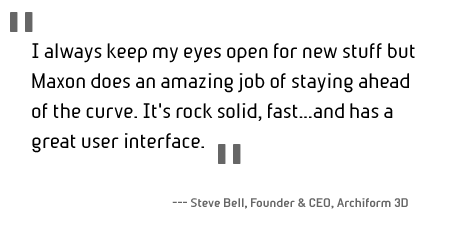Continued from page 2
The Porsche Tower Project
AFR: So you said only a small percent of your work is in the Miami area but one project, the Porsche Tower project is definitely there and definitely quite interesting. Can we talk about that a bit?
SB: Sure. That project is really quite special and I’m grateful to have been a part of it. The Porsche Tower in Miami is a luxury high-rise residential tower with integrated personal car lifts (elevators) that take your car directly to your own garage next to your unit in the tower. It’s extraordinary. We did it fully in ArchiCAD. It changed more than five times, but that’s the beauty of ArchiCAD is we are able to execute quickly and adapt to change with a program like that.
The most important thing we helped solve was to present the sophisticated car elevator issues. And we did the entire project within weeks from the ArchiCAD work to the CINEMA 4D work. And I mean weeks, including design interpretations, redesign–as Sieger Suarez of Porsche threw ideas around–renders, animations and glitches worked out.
AFR: That sounds intense.
SB: We were sending draft versions of the animation nearly daily to the client with their engineers able to easily see where all the headaches were going to be. The animations became invaluable to the design and development process. Porsche would fly in from Germany, the client was in Miami, I would take the boat over and we would get around the table and solve these problems. That’s something that a Chinese high-volume, low-cost render shop can’t do.
It’s a very powerful thing to be able to convey an occupant driving their car into a glass elevator and staying inside the car while the elevator takes them to their personal garage at their apartment up in the sky…I mean, just to explain that on paper to the building authorities would have been nuts! But if you show it in 3D it all makes sense.
Shop Talk: The Archiform 3D Pipeline
AFR: Our readers love seeing the work others do but one thing they always want to focus on is the tools used to get the job done. Can you tell me a bit about your unique pipeline and workflow tools?
SB: It started with ArchiCAD. We have been on it since version 3 or something. Way back…
I started dabbling with CINEMA 4D in the early 90’s. In fact, you had mentioned education at one point, back then there was no Internet. No public forums or anything like that. And it wasn’t until after a year after that the Post Forum website went up. We were just a bunch of guys with this new technology–we were pioneers–and we would share what we were doing and help each other out. Training CDs, training websites–these things didn’t exist back then.
AF: So that is the core of your workflow? But I know you do camera tracking so can you talk a little bit about that?
SB: Sure, I use SynthEyes for that because it runs on both Mac and Windows. I have this policy now where I will not use any software that is not on both Mac and Windows.
AF: Please explain.
SB: Well yeah, because I own about 40 Windows machines but I use a Mac on my desk. My entire render farm is just about all Windows boxes with the main master machine being an Apple Xserve, which sadly is going to have be switched out soon as there is no new follow-through product from Apple to move to.
AF: So what is running on the Xserve versus the 40 PCs?
SB: The Xserve is running CINEMA 4D Server. But keep in mind that we now have Team Render, which I have switched to. So it is running the master version of CINEMA 4D. All the PCs are render slaves and are stripped down boxes. And this is because you can’t buy a stripped down Mac that is just about the horsepower.
I greatly prefer the Mac OS X environment–which is why I personally work on it–but my business is about speed, client schedules, and dollars and fortunately for us, CINEMA 4D’s excellent cross-platform abilities and network rendering technology enables me to optimize the scenario that is right for me and my business. Because of the render farm and because I built inexpensive render slave boxes, I have incredible fire power behind my CINEMA 4D pipeline.
AF: So how do you reach your Xserve and render farm from your home in the Bahamas? How do you tap that power if you are holed up in a design review meeting in London with your clients? Are you able to tap the power of your Render Farm from there?
SB: Absolutely. I usually have a fully loaded MacBook Pro and can do a lot with that with clients but it has limitations. If I need a lot of power, am away from my workstation, and have reasonable Internet speeds I can use Logmein to reach the Xserve and CINEMA 4D on that with the power of the render farm behind it.
So using Logmein I can go in run the process I need and just collect the results and do what I need to with that. Sometimes I have great Internet and I’m just fine.
Favorite Features in CINEMA 4D
AF: So what are some things that you like about CINEMA 4D beyond what you have mentioned before? Can you talk a bit about the features that stand out to you, the user interface, etc?
SB: The main reason why I got into CINEMA 4D is because there weren’t too many options back then. So there are historical reasons, I admit that. But the more I got into it the more I realized that it is damn good software. I always keep my eyes open for new stuff but Maxon does an amazing job of staying ahead of the curve. It’s also rock solid, fast, has great network rendering, runs cross platform and has a great user interface. Just when I think I’m maybe getting envious of another platform and consider straying they always hook me again–like with the new Team Render. It’s fantastic!
AFR: What kinds of other things have caught your eye?
SB: I keep up up with new technology as best I can and always see what the newcomers at universities are up to. I have recently trialed the GPU-based iray system and am always reassessing Vray. CINEMA 4D has an option for Vray as well, so whenever I begin to get a little bit of 3D envy I take a deeper look.
AF: So what do you think about Vray?
SB: It is a very good rendering engine, no doubt. But it comes at a price of longer render times. So I tend to stick to the rendering engine in CINEMA 4D and that’s because my clients can’t wait that long. We work very quickly and as I said earlier the way we work we are more than just providers of renders and animations. It’s the whole process and how we take care of our clients’ every need giving them exactly what they need in the end.
AF: There are different rendering options in C4D, are you using the physical rendering option or the standard options?
SB: I tend to use the standard GI renderer rather than the physical renderer. The reason being that the physical renderer tends to chew up too much memory for me for my work. I need render instances and the memory input on those was slowing my work down with the physical renderer. Those are incredibly important for my work.
next page: The New Mac Pro: The Good, the Bad, and the Not So Ugly









Reader Comments
Jade Pearl liked this on Facebook.
Asia Panek liked this on Facebook.
David Silverman liked this on Facebook.
Lucia Lagarda liked this on Facebook.
Comments are closed.